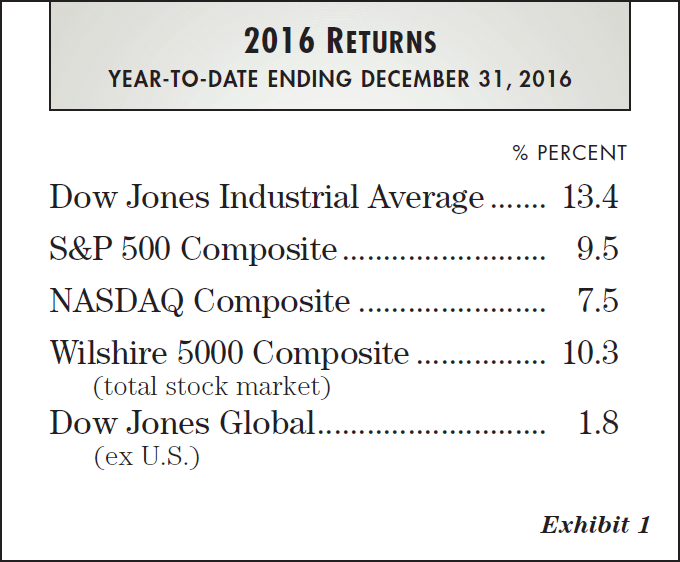 What Really Happened?
The year started out with investors getting shocked with an -11% down-market move in the first three weeks of January. Investors exited from stocks as crude oil fell to $26 a barrel, and ongoing concerns over the Federal Reserve’s monetary policy persisted. After a brief recovery into April, the stock market wandered trendlessly back and forth until the November election. From that point, Hope started to spring eternal, as the U.S. stock market moved significantly higher. Notice in Exhibit 2 the U.S. stock market, as measured by the broadly based S&P 500 Composite, before election day was lower than it was at the same time the previous year. The real boost came after election day.
What Really Happened?
The year started out with investors getting shocked with an -11% down-market move in the first three weeks of January. Investors exited from stocks as crude oil fell to $26 a barrel, and ongoing concerns over the Federal Reserve’s monetary policy persisted. After a brief recovery into April, the stock market wandered trendlessly back and forth until the November election. From that point, Hope started to spring eternal, as the U.S. stock market moved significantly higher. Notice in Exhibit 2 the U.S. stock market, as measured by the broadly based S&P 500 Composite, before election day was lower than it was at the same time the previous year. The real boost came after election day.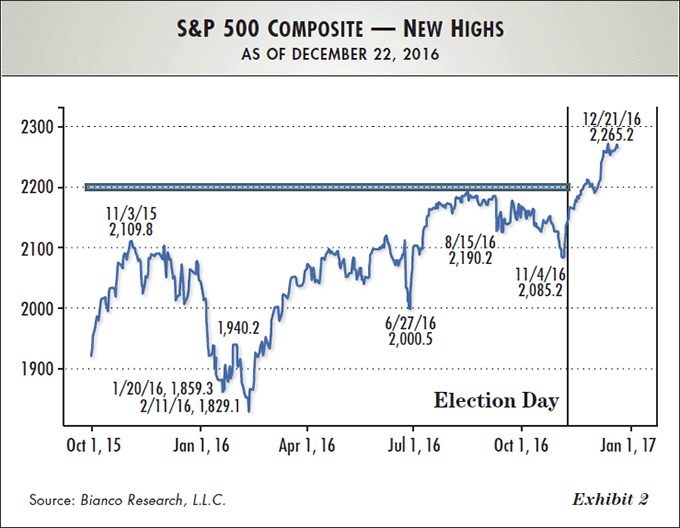 In contrast, worldwide stock markets (since this past November’s election in the U.S. through year-end 2016), did not fare as well. Here are just three examples: India down -1%, Hong Kong down -8% and Korea down -1%. Also of interest, Exhibit 3 traces the price movement of the MSCI Emerging Market Index (another worldwide market measurement) as it declined almost -8% after the U.S. election, versus the 6% gain in the U.S. stock market, as measured by the S&P 500 Composite. In addition, the Dow Jones Global index (excluding the U.S.) was up a mere 1.8% for 2016.
In contrast, worldwide stock markets (since this past November’s election in the U.S. through year-end 2016), did not fare as well. Here are just three examples: India down -1%, Hong Kong down -8% and Korea down -1%. Also of interest, Exhibit 3 traces the price movement of the MSCI Emerging Market Index (another worldwide market measurement) as it declined almost -8% after the U.S. election, versus the 6% gain in the U.S. stock market, as measured by the S&P 500 Composite. In addition, the Dow Jones Global index (excluding the U.S.) was up a mere 1.8% for 2016.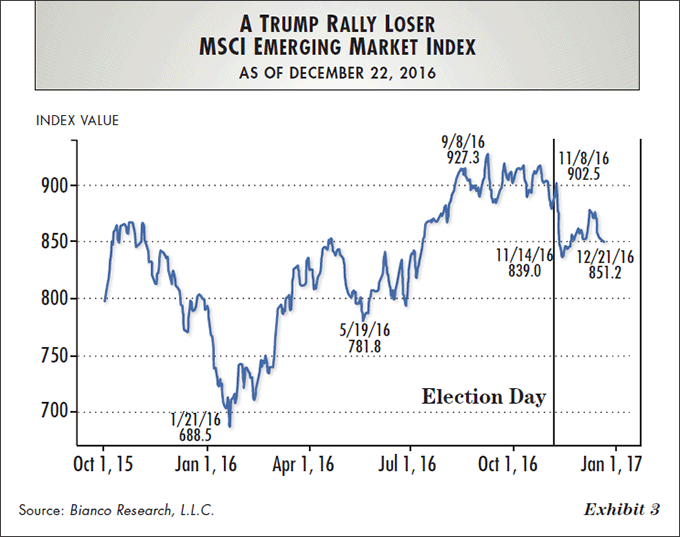 Are we at Oxbow pleased with the performance of the U.S. stock market in 2016? By all means, yes, but we also feel there is a strong likelihood that last year’s sizable year-end rally borrowed quite a few future gains from 2017.Oxbow-managed equity strategies returns varied last year. It was the first year in some time that Value Stocks generally performed better than Growth Stocks. The Oxbow Multi-Cap strategy (value-based) was the leader, while our Dividend Growth strategy was second, and our Long-term Growth strategy came in third. Meanwhile, Oxbow’s Income returns also were positive, but managing the volatility in this category was a real challenge throughout the year. As we enter the new year, stock prices (from a historical standpoint) are not currently cheap. Consequently, we advise investors to be very careful about what and when to buy. Exhibit 4 shows the overall stock market’s current price/earnings multiple… Prices versus Earnings (P/E) are stretched. The current S&P 500 price is discounting about $140 per share of earnings. This, in our opinion, appears to be unattainable.
Are we at Oxbow pleased with the performance of the U.S. stock market in 2016? By all means, yes, but we also feel there is a strong likelihood that last year’s sizable year-end rally borrowed quite a few future gains from 2017.Oxbow-managed equity strategies returns varied last year. It was the first year in some time that Value Stocks generally performed better than Growth Stocks. The Oxbow Multi-Cap strategy (value-based) was the leader, while our Dividend Growth strategy was second, and our Long-term Growth strategy came in third. Meanwhile, Oxbow’s Income returns also were positive, but managing the volatility in this category was a real challenge throughout the year. As we enter the new year, stock prices (from a historical standpoint) are not currently cheap. Consequently, we advise investors to be very careful about what and when to buy. Exhibit 4 shows the overall stock market’s current price/earnings multiple… Prices versus Earnings (P/E) are stretched. The current S&P 500 price is discounting about $140 per share of earnings. This, in our opinion, appears to be unattainable.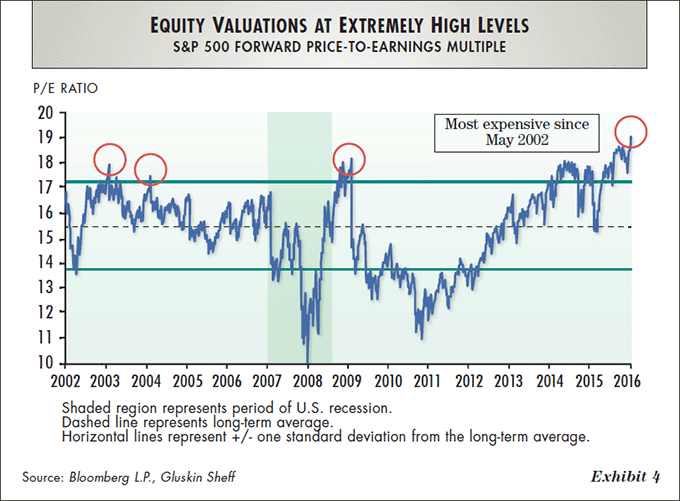 Interest Rates
Since last May we have been warning investors of the adverse effects of a potential quick rise in interest rates. In our October 2016 Market Comments, we reemphasized the sizable impact that a change in the level of interest rates would have on the 30-year and 10-year U.S. Treasury bonds. The graphs in Exhibit 5 show the -19% price decline in the 30-year Treasury and the corresponding -10% decline in the 10-year Treasury that occurred since mid-July 2016 to the recent low in December. (The bulk of the declines came after election day.)At Oxbow we think the rise in interest rates is probably over for now. Sad to say… the Federal Reserve, in our view, just can’t see it. Low inflation is the main factor. Consider the following price trends that have occurred among various segments of the U.S. economy over the past 12 months: Delivery Services up a mere +0.3%, Food down -0.4%, Home Improvements down -0.9%, Motor Vehicles down -1.1%, Furniture down -2.7%, Appliances down -0.4% and Airfares down -6.6%. Meanwhile, home-mortgage rates, as shown in Exhibit 6, have risen rapidly, which has the net effect of slowing the economy.All these aforementioned conditions point to price stability and not runaway inflation. At Oxbow last year we were negative on bonds from June through September. Lately, though, we are starting to see some interesting buying opportunities. The rise in interest rates that we expected to occur came hard and fast, but now it looks like higher rates have been overdone, at least for the coming 6–12 months.
Interest Rates
Since last May we have been warning investors of the adverse effects of a potential quick rise in interest rates. In our October 2016 Market Comments, we reemphasized the sizable impact that a change in the level of interest rates would have on the 30-year and 10-year U.S. Treasury bonds. The graphs in Exhibit 5 show the -19% price decline in the 30-year Treasury and the corresponding -10% decline in the 10-year Treasury that occurred since mid-July 2016 to the recent low in December. (The bulk of the declines came after election day.)At Oxbow we think the rise in interest rates is probably over for now. Sad to say… the Federal Reserve, in our view, just can’t see it. Low inflation is the main factor. Consider the following price trends that have occurred among various segments of the U.S. economy over the past 12 months: Delivery Services up a mere +0.3%, Food down -0.4%, Home Improvements down -0.9%, Motor Vehicles down -1.1%, Furniture down -2.7%, Appliances down -0.4% and Airfares down -6.6%. Meanwhile, home-mortgage rates, as shown in Exhibit 6, have risen rapidly, which has the net effect of slowing the economy.All these aforementioned conditions point to price stability and not runaway inflation. At Oxbow last year we were negative on bonds from June through September. Lately, though, we are starting to see some interesting buying opportunities. The rise in interest rates that we expected to occur came hard and fast, but now it looks like higher rates have been overdone, at least for the coming 6–12 months.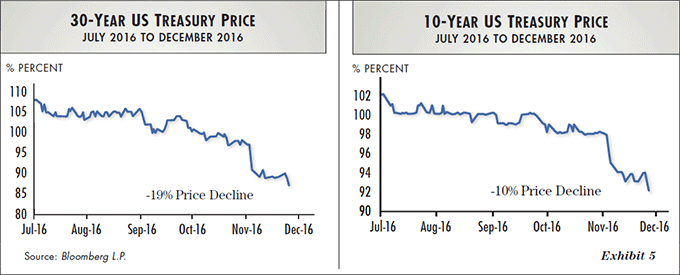 Where Are We Now?
A number of predictions we made regarding 2016 did take place. Oxbow started calling for higher oil prices early in March of last year. We gave a speech on February 24, 2016, in San Antonio to the American Association of Drilling Engineers that outlined our 2016 year-end forecast of the price of Texas Intermediate Oil to the $50–$70 level. (At the time the price was at $26 a barrel.) Also, in May 2016 we stopped buying bonds past two- to three-year maturities. We sensed there would be a swift move the other way. In our High Income strategy, we swapped a number of holdings in January and February into higher-quality issues, and that also worked.At this time we see the stock market rally since November’s election based more on Hope than Substance. In reality, little has really changed but perception, and markets reacted. We caution that valuations are historically sky-high now. Consequently, we feel that investors must be extremely picky. Some of the same people who were heavily selling their stock holdings last January at lows are now coming back into the stock market. Historically, this is not a great sign. The Fed, in our opinion, will not have the luxury of instigating a number of rate increases, as it has mentioned. If it does, a recession is likely to follow. With total U.S. debt at 275% of GDP (Gross Domestic Product), it would be hard to justify further rises in interest rates. Presently, we at Oxbow are invested in both high-quality stocks and bonds. Some of our investment strategies have more cash reserves than others.
Where Are We Now?
A number of predictions we made regarding 2016 did take place. Oxbow started calling for higher oil prices early in March of last year. We gave a speech on February 24, 2016, in San Antonio to the American Association of Drilling Engineers that outlined our 2016 year-end forecast of the price of Texas Intermediate Oil to the $50–$70 level. (At the time the price was at $26 a barrel.) Also, in May 2016 we stopped buying bonds past two- to three-year maturities. We sensed there would be a swift move the other way. In our High Income strategy, we swapped a number of holdings in January and February into higher-quality issues, and that also worked.At this time we see the stock market rally since November’s election based more on Hope than Substance. In reality, little has really changed but perception, and markets reacted. We caution that valuations are historically sky-high now. Consequently, we feel that investors must be extremely picky. Some of the same people who were heavily selling their stock holdings last January at lows are now coming back into the stock market. Historically, this is not a great sign. The Fed, in our opinion, will not have the luxury of instigating a number of rate increases, as it has mentioned. If it does, a recession is likely to follow. With total U.S. debt at 275% of GDP (Gross Domestic Product), it would be hard to justify further rises in interest rates. Presently, we at Oxbow are invested in both high-quality stocks and bonds. Some of our investment strategies have more cash reserves than others.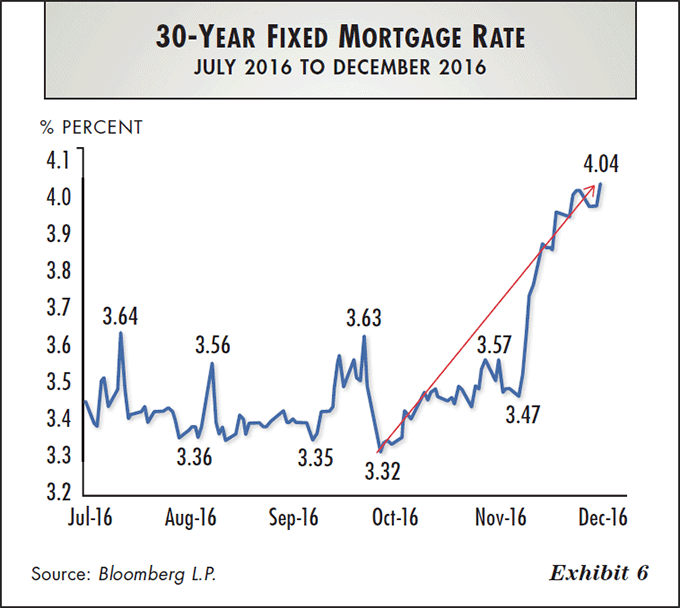 Historically, the first year of new presidential terms can be tricky. This will likely be the case again in 2017. Our toughest assignment as money managers is to determine if the many pre-election campaign promises can soon be delivered. Throughout the years, markets have had a way of fooling most people, and 2016 proved no different. Oxbow’s ongoing conservative investment approach, preservation of capital, will always dictate where we go with investments in the months and years ahead. Having said that, we are dedicated to taking advantage of investment situations that warrant a second look.In Summary
Yes, 2016 was indeed a “Topsy-Turvy” year. As much as we wish it wasn’t so, considerable uncertainty remains, both politically and economically. Our crystal ball at this time tells us that 2017 could well be more of the same as Perception and Reality often meet along the way.We appreciate all of you, and we wish you a Healthy and Prosperous New Year.Ted Oakley
Bob Walsh
Historically, the first year of new presidential terms can be tricky. This will likely be the case again in 2017. Our toughest assignment as money managers is to determine if the many pre-election campaign promises can soon be delivered. Throughout the years, markets have had a way of fooling most people, and 2016 proved no different. Oxbow’s ongoing conservative investment approach, preservation of capital, will always dictate where we go with investments in the months and years ahead. Having said that, we are dedicated to taking advantage of investment situations that warrant a second look.In Summary
Yes, 2016 was indeed a “Topsy-Turvy” year. As much as we wish it wasn’t so, considerable uncertainty remains, both politically and economically. Our crystal ball at this time tells us that 2017 could well be more of the same as Perception and Reality often meet along the way.We appreciate all of you, and we wish you a Healthy and Prosperous New Year.Ted Oakley
Bob Walsh